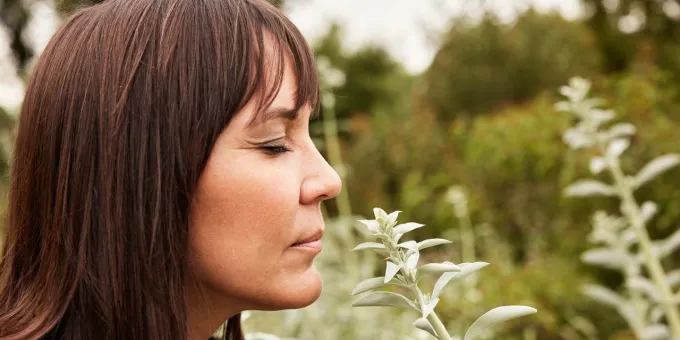In “Hermosa,” fine art photographer Cara Romero makes a compelling case that Los Angeles is still a holy place. The 2021 black-and-white photograph features Romero’s daughter standing in the waves of the Pacific dressed as Ocean Woman, part of the Chemehuevi creation story.
“In pre-colonial times [Los Angeles] was an area of creation,” Romero says now, “a sacred area to many native tribes. We wanted to take portraits in those places that were still intact in L.A.”
The piece was part of Tongvaland, a COVID-era exhibit of Native American works displayed on Los Angeles–area billboards. While “Hermosa” well represents a style that is often associated with Romero—a mix of traditional and contemporary imagery—her career has spanned well beyond billboards. Her pieces have found homes in collections of major museums around the globe, including the Smithsonian National Museum of the American Indian, the National Museum of World Cultures in the Netherlands, and the Guggenheim.
“I worked in a smaller way,” Romero says, noting that she started out showing her pieces at Indian markets. “I never imagined I would have work in the Met and the MoMA and the Crocker and the Autry and on and on.”
Romero’s pieces also appear in many other museums around the Golden State, including the Los Angeles County Museum of Art, The Huntington, and the Palm Springs Art Museum. In 2024, her “Three Sisters” will be part of Future Imaginaries: Indigenous Art, Fashion, Technology at the Autry Museum of the American West (Sept. 7, 2024–June 21, 2026), an exhibition showcasing 50 futuristic works by Indigenous artists.
The appeal, no doubt, comes from her striking, colorful imagination. Take “The Zenith,” which depicts an astronaut floating in space as cobs of corn orbit around him. “We remember that while life and culture is always changing,” Romero writes about the piece on her website, “some things are ever-permanent.”
From Anthropologist to Artist
That dual reality is something Romero has known all her life. Born in Inglewood, outside Downtown Los Angeles, Romero grew up in two worlds after her parents’ divorce, splitting her time between her mom’s family in Houston and her dad’s family on the Chemehuevi reservation—located on the eastern edge of San Bernardino County, next to Lake Havasu and the Arizona state line.
At the University of Houston, Romero first majored in cultural anthropology, but then took an elective class in photography and found her calling. “I was interested in telling contemporary Native stories but hadn’t really been exposed to formal photography until I stumbled into the class,” she says. “It was an instant love—I understood that photography was a more powerful pathway for me to visually communicate contemporary indigenous life and issues.”
During her continued studies and burgeoning career, she found a lot of support when visiting the reservation. “The cultural arts are something that we practice in community, and we rely upon each other intergenerationally for those arts,” she says. “While photography was an unusual thing to pursue, that intergenerational support stayed true. I would go home to make or share photographs, and I look back and realize I would never have had the courage to pursue it unless the elders had encouraged me.”
Chemehuevi Life
Today Romero still divides her time, living with her family (including husband Diego Romero, a Cochiti Pueblo artist) in both Santa Fe and on the Chemehuevi reservation—which, she says, has happily not changed a lot since her youth. “It’s very family-oriented, and very community-oriented, meaning life is centered around the elders and the community,” she says. “It’s very rural.”
The reservation is on the banks of the Colorado River and Lake Havasu, and also a short drive from Joshua Tree National Park and the Mojave National Preserve. “People think of this area as barren, but it’s one of the most biodiverse areas the world, and rich with Indigenous history,” she says. “We breathe clean air, drink clean water, we fish, we hike, and swim a lot on the Colorado River. There’s no fast food or movie theaters, or anything like that. We protect our environment, so our natural world is very intact. And we’re very reliant on each other—for eating, for socialization, and happiness.”
Back in Los Angeles, Romero often shifts into a different mode: “I like to reconnect with family in Redondo Beach, and I find myself more of a tourist rather than someone who is from there. We go to the La Brea Tar Pits, the LACMA, The Hammer. I can’t wait to go to the Lucas Museum, which will be about storytelling and the narrative arts. I’m going to have piece in their collection, so I’m excited about that.” (Ed. note: Lucas Museum of Narrative Arts is expected to open in 2025.)
The Right Place at the Right Time
Romero readily admits she’s amazed at the reach her work has found. “I am 46 and grew up without seeing Native Americans portrayed accurately in culture or academia,” she points out. “I was pursuing it out of love—love of my community—and never expected there to be such an awakening in American institutions, to try to reckon with the dark history of exclusion and erasure of Native Americans as part of American art and history.”
In recent years, however, she says she has seen a shift. “So many American institutions—museums, schools and universities—seem to be trying to address the last 100 years of purposeful exclusion,” she says. “So I have been surprised to be in the right place at the right time. While my voice is small, it does make a difference.”
